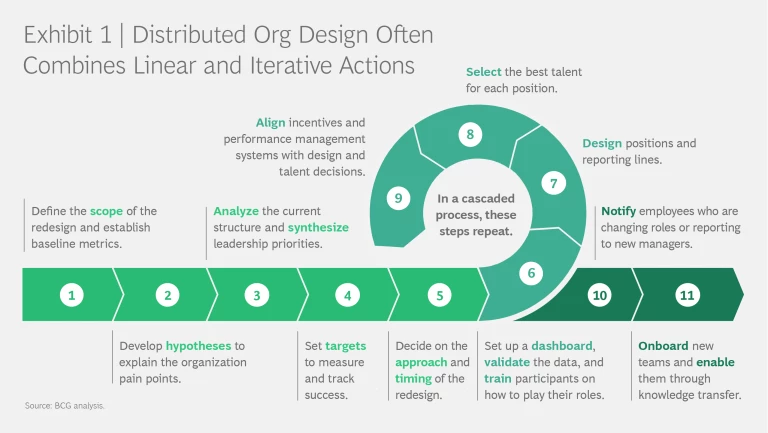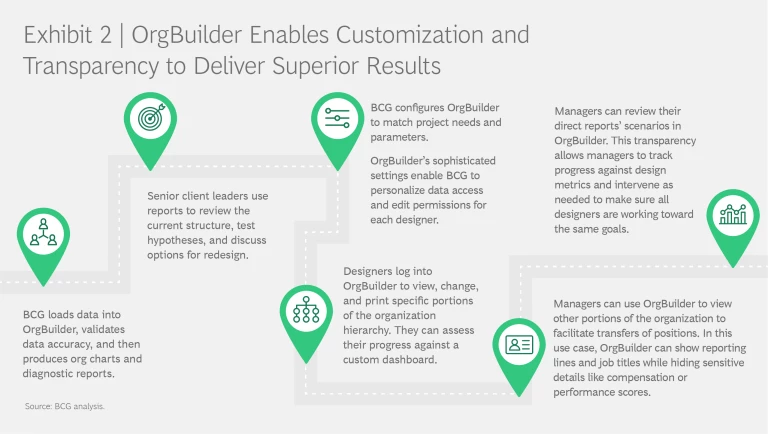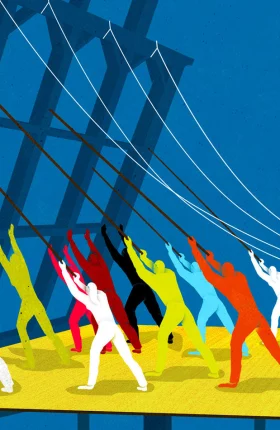Organizations are facing intense pressure to remain agile and adapt to new priorities, working models, and trends. For some companies, this means transforming their operating model, moving to a platform organization, or adopting a more agile stance with functional experts deployed to multidisciplinary teams. For others, it could mean integrating an acquisition, spinning off a subsidiary, creating a shared service center to optimize a certain function, flattening the organization by removing layers to improve efficiency, or embracing a design philosophy like zero-based organization.
BCG’s distributed approach to design puts managers at the center of the redesign process and delivers better results by empowering them to shape their teams.
All these strategic choices require organization design , which involves developing a detailed new structure, aligning performance metrics to roles, and identifying the best talent to fill those roles. Unlike a traditional, top-down process, BCG’s distributed approach to design puts managers throughout the organization at the center of the redesign process and delivers better results by empowering them to shape their teams. This distributed approach makes it easy for hundreds of designers to work together cohesively while redesigning thousands of positions.
BCG’s patented, proprietary OrgBuilder tool gives managers an intuitive, secure, and scalable platform on which to perform distributed org design. OrgBuilder can be customized to give designers fast access to the specific data they need in order to meet their org design objectives.
The Advantages of Distributed Org Design
Our firm has extensive experience assessing corporate structures, redesigning them, and implementing new and improved org designs across all industries and regions.
BCG has found that clients get the best results using a distributed approach to design, where managers deep within the organization who are closest to the work are responsible for defining roles and aligning people with positions. Distributed design often starts at the top of the organization and then moves downward from one layer to the next in an iterative, cascading process with each manager designing, selecting, and notifying the next level of positions that report directly to him or her. (See Exhibit 1.)
In a standard, hierarchical, and centralized process, a select group of senior executives, supported by a few consultants, come together to design the organization and choose people to fill the new structure.
By comparison, the distributed-design process has four key advantages:
- It empowers managers to act according to their direct experience. Managers have hands-on involvement and know how work gets done on a day-to-day basis. This puts them in the best position to define required roles, determine how those roles should work together, and identify the most appropriate KPIs to measure performance at each level.
- It improves the odds of finding the best talent for each role. Mid-level and junior managers often have more granular knowledge than senior executives do about the talent that exists deep within the organization. This means that managers can select people for positions in a way that aligns talent with the needs of the business while supporting the growth and development goals of individuals.
- It encourages engagement and improves morale. Distributed design gives managers a sense of ownership and accountability for the new structure. This can boost engagement and enthusiasm by showing managers that senior leaders trust them to make important org design, selection, and implementation decisions.
- It strengthens horizontal alignment. Distributed design gives managers opportunities to clarify responsibilities with their peers, spell out decision rights, and clear up pain points that might not be visible to senior leaders in a typical executive-led design process.
Using Data to Fuel Distributed Design
Data underpins the entire org design process. Primary data inputs such as reporting lines, job titles, and employee-specific information generate secondary data fields, which can describe attributes like span of control, or the size of a manager’s organization.
Each designer in the distributed process uses both primary and secondary data to design new structures and assess the impact of changes. Both types of data can be used to measure progress or identify where stated objectives have not been met, such as promoting a certain percentage of high-performing employees.
Org design projects depend on massive amounts of data. The majority of org design initiatives supported by BCG involve thousands or even millions of individual transactions, including edits to person or position records, changes in position compensation, and appointments of managers to new roles. Without the right combination of process and technology to access, manage, and visualize data, such projects can quickly devolve into exercises in data management. If that happens, designers and program managers will likely fail to meet their design and talent objectives, thus hurting the morale of the entire organization.
OrgBuilder has the capacity to synchronize the alignment of massive data flows and keep org design projects on track. Its highly configurable interface puts key metrics front and center for each user while making it easy for leadership to monitor overall progress and steer projects back on course as needed.
Since launching the platform in 2010, BCG has used OrgBuilder in more than 3,000 projects. By codifying and systematizing the data element of org design, OrgBuilder allows designers and program managers to focus their time and energy on meeting key strategic goals. (See Exhibit 2.)
A Wide Variety of Capabilities
OrgBuilder supports an almost infinite array of configurations to meet unique client needs. Whether they want to design for growth, change their operating model, or integrate two companies, clients can customize OrgBuilder to define which metrics to measure, who has access to which positions and which talent, how to measure progress toward org design goals, and so forth.
OrgBuilder supports an almost infinite array of configurations to meet unique client needs.
To keep designers focused on the key goals of an org design project, OrgBuilder’s workspace can be configured to prompt users to take certain actions or skip unnecessary steps. For example, vacant positions can be shaded a specific color so that designers and HR professionals are encouraged to confirm that those positions are truly vacant. Conversely, OrgBuilder can be configured so that designers can view but not make changes to certain fields, such as employee start dates, that are not relevant to the company’s strategic goals.
OrgBuilder’s other benefits include:
- Security. The platform prioritizes the secure retention and transmission of sensitive, personally identifiable data. OrgBuilder’s permissions model ensures that individual users have access only to the position or person records and fields they need in order to execute their own role in the design process.
- Visualization. OrgBuilder illustrates organization data in a two-dimensional org chart format. Users can navigate easily throughout their organization, making changes that are automatically updated in the underlying data and the visual interface.
- Positions Before People. The platform asks managers to first make strategic decisions about positions they need and then find the best talent from across the organization to fill those jobs. OrgBuilder encourages and manages peer-to-peer interaction among designers to determine which candidates are the best fit for each role.
- Error Reduction. Some org design methods make it too easy to accidentally delete data or remove critical positions. If that happens, companies can lose track of valuable employees, who are then excluded from the talent selection process. OrgBuilder’s conditional formatting highlights incomplete work or inconsistent design elements to help designers and leaders make sure that work is completed accurately.
- Flexibility. OrgBuilder isn’t constrained by traditional hierarchies. It allows designers to build and staff agile project teams, where the employees continue to occupy positions in more permanent, discipline-based administrative structures.
OrgBuilder’s intuitive interface and highly customizable nature enable systematic, data-driven, end-to-end reorganization efforts. With its secure, scalable architecture, OrgBuilder facilitates distributed-design best practices and allows managers to focus on placing the most capable employees in positions where they can make the greatest contributions.
A Success Story: Faster Redesign, Deeper Cost Savings
Organizations can achieve significant benefits by deploying OrgBuilder in a distributed-design context. Consider the example of BCG’s work with a large technology services company that doubled in size through an acquisition. The combined company needed to integrate tens of thousands of positions while moving to a new operating model. As part of this transition, the client also chose to reduce overhead and create a leaner organization structure. BCG partnered with the company to create an org design program leveraging distributed-design methodology.
In the initial stages of the engagement, BCG consultants worked with client executives, HR teams, and project managers to design the operating model and the top of the organization structure. As the design cascaded into lower layers of the organization, the client’s geographical scope prevented collocation. More than 800 managers would need to serve as designers in order for both legacy companies to share knowledge of their work and their teams.
OrgBuilder provided a solution, giving these hundreds of managers the instant ability to view and design their portion of the organization. To ensure that the project met objectives within a rigorous timeline, our team facilitated more than 200 digital review sessions with designers and their leaders.
OrgBuilder gave client teams in the US, Europe, and Asia the ability to participate in the organization redesign effort at the same time. The platform thus enabled simultaneous engagement in each phase of the distributed-design process.
Instead of relying on consultants to model the impact of org design decisions, OrgBuilder empowered the client to make design changes and then see those decisions reflected immediately in a live database. This allowed the BCG team to engage at a higher level as a thought partner, helping the client’s managers think through their design options and the strategic implications of their choices.
Prior to the engagement, the client had estimated that it would take 29 months to design a new organization structure. Leveraging the power of OrgBuilder, the client completed the operating-model shift and detailed org design in just 6 months.
OrgBuilder delivered results five times faster with twice the estimated run rate labor savings.
Cost reductions also surpassed the client’s expectations. BCG had projected that the project would deliver $50 million in run rate labor savings. Actual results were more than $100 million in run rate savings, with the streamlining of two layers of the organization structure.
“This was the most successful consulting engagement I have observed in my career,” said the client’s COO.
Learn More About BCG’s Latest Thinking on Org Design
- Discover A New Approach to Organization Design to define the purpose of a reorganization initiative, identify which behaviors will support that purpose, and then take action to promote those behaviors.
- Learn how companies can prepare for the digital future by taking a centralized, decentralized, or hybrid approach on the way to the ultimate goal of embedding digital strategy and capabilities into their organizational DNA.












